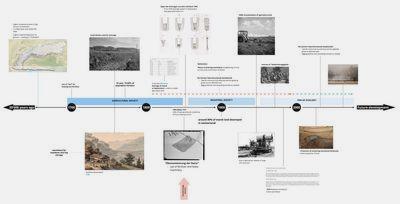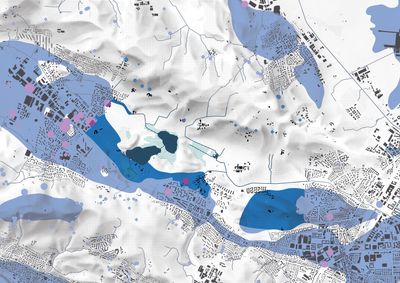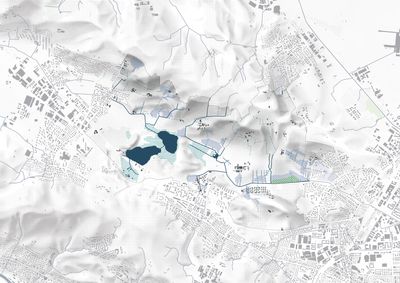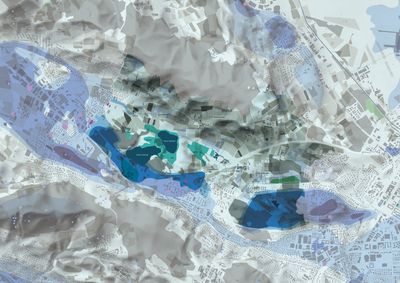AtlasHydrotopiaAlexander Meier, Aron Karrer, Jan Aebi, and Alan Thomas
When we explore the area we find lots of different typologies of water infrastructure. The human-made control mechanism of our society leads to a complex system of irrigation, storing and draining water layered on top of each other.
In the area of Zürich Nord we find a variety of different landscapes. From the nature reserve around the Katzenseen to the nearby agricultural land and the surrounding urban spaces of the three municipalities Zurich, Regensdorf and Rümlang. The two lakes located in the Northeast of our site are surrounded by a buffer zone of remaining swamp land. The Furtbach flowing to the Northeast and the Chatzenbach flowing to the nearby Büsisee next to the national highway A1 across our site. A new wetland surface was implemented on the southern side of the Chatzenbach called “Allmend Katzensee” to restore parts of destroyed wetlands. The water sources on the site are put under huge stress through different factors such as fertilisation, climate change and the need for more sealed surfaces.
The History of Water Use in Zürich Nord


Historical water map showing changes since 1850. Source: GIS Kanton Zürich.
The landscape of Switzerland was heavily formed by glaciers that reached 20,000 years ago from the alps to the Southern tip of the lake of Zurich. Due to a long lasting warmer period meltwater formed lakes and wetlands. When we look at the closer past of the wetlands and water bodies in Switzerland we see that they were transformed by three influential societies. Starting at the 1700 with the agricultural society which mainly lived with the surrounding wetlands using them mainly for hay storage and meadows. In the 18th. century around 70–80 % of the population were farmers. From the 1850s onwards industrialisation lead to the “economisation” of marshland, rivers and lakes. A newly implemented drainage system consisting of clay tubes were implemented in order to drain big parts of wetlands. Newly gained agriculture fields were used for intensely cultivated land. Heavy machinery, fertiliser and petrol gained a key role in order to maximize yields. Around Zurich, wetlands were additionally drained by applying gravel on affected areas. Straightening of rivers courses were an additional tool in order to maximize drainage rate. In the 1900s around 90 % of marsh land was destroyed in Switzerland. From the 1950 to today industrialization merged into todays era of ecology. The awareness for water pollution and protection of biodiversity emerged. The importance of the Katzensee swamp land was detected and was set under protection with the “Rothenthurm-Initiative” in 1974. Today, the direction of restoring destroyed wetlands and waterbodies in order to create healthy habitats for water supplies and biodiversity leads us to what we already had back in the 1700.
Water Supplies

Groundwater map. Source: GIS Kanton Zürich.
- Medium thickness (2-10m)
- Low thickness (< 2m)
- Below usable thickness
- Medium thickness (2-10m)
- Low thickness (< 2m)
- Below usable thickness

Water catchment map. Source: GIS Kanton Zürich.
 Groundwater catchment >3000l/min
Groundwater catchment >3000l/min Groundwater catchment 300-3000l/min
Groundwater catchment 300-3000l/min Groundwater catchment 30-300l/min
Groundwater catchment 30-300l/min Groundwater catchment <30l/min
Groundwater catchment <30l/min Spring catchment 300-3000l/min
Spring catchment 300-3000l/min Spring catchment 30-300l/min
Spring catchment 30-300l/min Spring catchment <30l/min
Spring catchment <30l/min Spring catchment without yield indication
Spring catchment without yield indication
 Groundwater catchment >3000l/min
Groundwater catchment >3000l/min Groundwater catchment 300-3000l/min
Groundwater catchment 300-3000l/min Groundwater catchment 30-300l/min
Groundwater catchment 30-300l/min Groundwater catchment <30l/min
Groundwater catchment <30l/min Spring catchment 300-3000l/min
Spring catchment 300-3000l/min Spring catchment 30-300l/min
Spring catchment 30-300l/min Spring catchment <30l/min
Spring catchment <30l/min Spring catchment without yield indication
Spring catchment without yield indication
Drainage System

Drainage map. Source: GIS Kanton Zürich.
- Drained Area
 Drainage
Drainage Potential Future Wetlands
Potential Future Wetlands
- Drained Area
 Drainage
Drainage Potential Future Wetlands
Potential Future Wetlands
Many fields were drained during the industrialization of agriculture in order to increase crop production and allow the use of heavier machines. The drained areas are predominantly situated on the south-facing slopes, where higher crop yields occur as a natural phenomenon.
Nowadays, many of the drainage pipes have reached the end of their life cycle and would need to be replaced. However, the question arises whether this is even the right choice. If we replace them, the soil use will continue in the same manner, carrying the same problems into the future. If they are removed or left to decay completely, areas could become waterlogged again, regenerating the soil and increasing biodiversity. This is especially important regarding climate change, as wetlands can store even more CO₂ as forests. A small number of sites have already been selected as potential future wetlands, but the resistance of farmers slows down this process significantly.
Water Consumption Agriculture

Water consumption map. Source: GIS Kanton Zürich.
- 500l/m^2
- 350l/m^2
- 250l/m^2
- < 150l/m^2
- 500l/m^2
- 350l/m^2
- 250l/m^2
- < 150l/m^2
Water consumption varies highly depending on the different crops being cultivated. To visualise the consumption on a map we categorised them based on water consumption from less than 150 litres per square metre to over 500 litres per square meter. The crops with varying water requirements are evenly distributed across the site putting no larger areas under particularly high pressure. This is in contrast to the neighboring Furt Valley where the substantial water demands of vegetable farming have been known to cause problems.

The water cycle begins with precipitation supplying the valley with water. Due to the site’s topography the water flows down naturally. A part of the surface runoff seeps away into the ground. After the first layers of soil the water will be captured in the aquifer leading down to the groundwater reservoir under the lower Chatzensee. The other part will run off on the surface due to either steep topography or sealed surfaces. The surface run off water will evaporate in running streams but mainly in standing water where it can be heated up constantly. The part which seeped away is eventually evaporated by plants due to transmission. In the end the emerging water vapor will be blown away by the wind, cooling down and condensate, again ending in precipitation. By doing so, closing the water cycle.
Human activities significantly influence the water cycle. This can occur through pollution or through deliberate redirection of water resources, impacting various stages in this natural process.

Narrative map. Source: GIS Kanton Zürich.
- Medium thickness (2-10m)
- Low thickness (< 2m)
- Below usable thickness
 Groundwater catchment >3000l/min
Groundwater catchment >3000l/min Groundwater catchment 300-3000l/min
Groundwater catchment 300-3000l/min Groundwater catchment 30-300l/min
Groundwater catchment 30-300l/min Groundwater catchment <30l/min
Groundwater catchment <30l/min Spring catchment 300-3000l/min
Spring catchment 300-3000l/min Spring catchment 30-300l/min
Spring catchment 30-300l/min Spring catchment <30l/min
Spring catchment <30l/min Spring catchment without yield indication
Spring catchment without yield indication- 500l/m^2
- 350l/m^2
- 250l/m^2
- 150l/m^2
- Medium thickness (2-10m)
- Low thickness (< 2m)
- Below usable thickness
 Groundwater catchment >3000l/min
Groundwater catchment >3000l/min Groundwater catchment 300-3000l/min
Groundwater catchment 300-3000l/min Groundwater catchment 30-300l/min
Groundwater catchment 30-300l/min Groundwater catchment <30l/min
Groundwater catchment <30l/min Spring catchment 300-3000l/min
Spring catchment 300-3000l/min Spring catchment 30-300l/min
Spring catchment 30-300l/min Spring catchment <30l/min
Spring catchment <30l/min Spring catchment without yield indication
Spring catchment without yield indication- 500l/m^2
- 350l/m^2
- 250l/m^2
- 150l/m^2




















